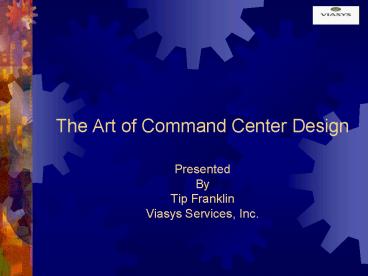The Art of Command Center Design PowerPoint PPT Presentation
1 / 19
Title: The Art of Command Center Design
1
The Art of Command Center Design
- Presented
- By
- Tip Franklin
- Viasys Services, Inc.
2
What is A Decision Support System?
- Gathers Information From A Number of Sources
- Processes the Information (Prioritizes, Distills,
Combines, Lists, etc.) - Presents it to a Decision Maker
- Facilitates the Decision
- Disseminates the Results of the Decision
- Checks on the Results of the Decision
3
Integrated Management System Philosophy
- Normal Operations
- Allow Functional and Sub-operating Systems to
Operate in a Decentralized Manner as Supported by
a Timely and Efficient Flow of Internal and
External Information. - Incident or Crisis
- Centralize Control to the Extent Required While
Allowing Remainder of System to Operate in a
Normal Fashion. This Brings a Sharp Focus on a
Problem While Allowing Unaffected Areas to
Continue in Normal Operation.
4
Transportation Management Systems
- Interface With and Derive Management Information
From - Transportation Infrastructure (Sensors, Toll
Booths, Travelers) - Official Observers (Highway Helpers, Tow Trucks,
Law Enforcement) - Traveler Information Providers
- Provide Information to Transportation
Managers/Planners/Users - Safe, Secure, Efficient, Economical and
Environmentally Sound - Economical and Controlled Growth of the
Infrastructure - Foster Economic Development
- Focus Information within the Decision Support
System - Coordinate Decision Making ( Both Planning and
Incident Response) - Handle High Stress Events
- Distribute Information Throughout the
Transportation Community (Driver, Rider, Shipper
and Enforcement) - Smooth Day-to-Day Communication Between
Agencies/Centers - Effective Decision Making
- Tie all elements (user, manager, et. al.) together
5
The Big 4!
- What is the Job?
- How Do I Want to Do It?
- What Do I need to Do It
- How Will I Measure Success?
6
The Vision!!!!
- The Vision Describes The Functional Requirements
of the System as It Will be 20 to 25 Years in the
Future
7
Benefits of The Vision
- Facilitates Efficient and Economical Budgeting
and Development of a System of Systems - Controls System Expansion
- Enhances Budgetary Programming and Execution
- Enables Establishment of Configuration Management
8
The Total System Perspective
- External Agencies and Organizations
- Environment
- Uncontrollable Variables
- - Political
- - Fiscal
- - Social
- - Technological
9
People
- Selection
- Criteria
- Turnover Considerations
- Training
- Initial
- Sustainment
- Certification
- Growth
- Testing
- New-hire
- Annual Proficiency
- Certification
10
Procedures
- Standard Operating Procedures
- Crisis Checklists/Plans
- Emergency Response
- Call Rosters
- Physical/Information Security
11
Hardware/Software/Communication
- Communication Package
- - Landline (dial and ring down) - Recording
- - Cellular - Conferencing
- - Radio (fixed and mobile) - Message Handling
- - Beeper - Secure/Non-secure
- - Radio/Wire Interface - PDA
- Automation
- - Database Management - Mainframe
- - Multilevel Security - Portable
- - LAN/WAN - Flexible
- COOP/Disaster Recovery
- Workstations/Consoles
- - Ergonomic Design - Flexibility
- - Exportability - Adjustability
12
Decision Aids
- Large Screen TVs
- CRTs
- Preformatted Displays
- Geographic Information System
- Message Traffic (Preformatted and Free Text)
- - Voice
- - Printed
- CCTV
- Alarm Monitors
- Automated Briefing Preparation Support
13
Facilities
- Operations Center
- Crisis Management Area
- Communication/Computer Room
- Protected/Redundant
- Uninterrupted Power Supply
- Life Support
14
System Engineering Process Description
Program Formulation (The Concept)
System Definition (Rqmnts.)
System Design
System Acquisition Development
System Integration Test
System Development (Start-up)
Life Cycle Support (Tech Refresh)
15
Integrated System Approach
- Cost and Schedules Estimates
- Programs Plans and Procedure Strategy
- Bid Package
- Conceptual Design
- Life Cycle Cost and Schedule
- System and Interface Specifications
- System Test and Acceptance
Program Requirements
System Tradeoffs And Analysis
- Decomposition
- of Mission
- Requirements
- Preliminary Drawings
Critical Item Evaluation
Preliminary Design
- Construction Drawings
- Procurements Packages
Final Design
- Risk Issues
- Resolved
- Site
- Characterization
- Future Technology
- Considerations
- Structure
- As Built Drawings
Construction
- Validated that All
- Requirements
- Included in Design
- Long Lead Items
- Approved for
- Procurement
- Staffing and
- Operating Plans
- Installation Drawings
- Functional Subsystems
- Interactive Subsystems
- Functional System
Installation and Integration
- Test Plans
- Test Procedures
Test and Operation
- Verify That Built As
- Designed and
- Requirements
- Achieved
- Validated Schedule
- Institutional Requirements
- Identified
- Staffing and Operating
- Concepts Identified
- Security Requirements
- Demographics
- Budget Project
- Other Projects
Maintenance
- Validated
- Requirements in
- Design
- Establish Training
- Program
- Training
- Manuals
- Drawings
- Upgrades
- Logs
- Identify Key
- Subsystems
- Identify Items
- For Test, Analysis
- Demonstration
- or Inspection
- Implement Test and
- acceptance Program
- Conduct Training
- Program
- Spares Analysis
- Availability
- Interchangeability
16
Strategic Plan Requirements
17
Configuration Management
- Should be Applied to All Aspects of the System
- Software/Hardware
- Communication
- Facilities
- Processes and Procedures
- Facilitates System Expansion and Growth
- Must Be Initiated at Earliest Stages of the
Project - Top Level System Requirements Down Through
Sub-System and Unit Level - Software Code
- Physical Construction and Installation
- Facility As Builts
18
Overall Lessons Learned
- You Must Have A Long Range Vision
- Users Must Identify Operational Concept as the
Baseline for All Future Development - Developers Must Work Closely with Users to
Validate Operational Requirements - Jurisdictional Issues are Tougher Than Technical
Challenges - Technology Issues are Primarily Cost and
Ease-of-Use - Adherence to Standards is Critical
- Rigorous Configuration Management Program Will
Save Time, Money and Trouble - Hot Transitions Must be Carefully Planned and
Executed to Avoid Interruption of Operational
Activities - Security Must Be Addressed From the Beginning
- Design From the Inside Out
19
- Thats All Folks!!

